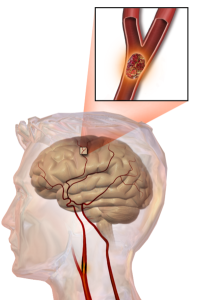[retweet][facebook]
Scalp acupuncture enhances neurologic repair and reduces cerebral edema due to an intracerebral hemorrhage (ICH), a type of stroke. Researchers conducted a laboratory experiment on laboratory rats and discovered that acupuncture improves neurologic functions following an ICH. Additionally, a biochemical analysis reveals that acupuncture regulates expression of MMP-9 (matrix metallopeptidase), an enzyme that breaks down extracellular matrix and is involved in tissue remodeling.
 Functional improvements included significant enhancements of limb bending, ability to stand, performance of voluntary movements, and a reduction of paralysis. The procedure used to achieve the clinical results was the application of the threading needle technique combined with scalp acupuncture. Acupuncture point Baihui (GV20) was connected to Xuanli (GB6) using the threading technique. The procedure was tested against a control group and demonstrated significant clinical efficacy in cerebral edema reduction, functional improvements, and regulation of MMP-9.
Functional improvements included significant enhancements of limb bending, ability to stand, performance of voluntary movements, and a reduction of paralysis. The procedure used to achieve the clinical results was the application of the threading needle technique combined with scalp acupuncture. Acupuncture point Baihui (GV20) was connected to Xuanli (GB6) using the threading technique. The procedure was tested against a control group and demonstrated significant clinical efficacy in cerebral edema reduction, functional improvements, and regulation of MMP-9.
Acupuncture enhanced resorption of blood stasis due to internal bleeding. Combined with acupuncture’s ability to regulate of MMP-9, the researchers suggest that these objective results contributed to the enhanced neurologic functional recovery and reduction of internal bleeding. The researchers gave a brief summary for the basis of the investigation citing prior research.
Wang Qiang et al. concluded that brain internal bleeding leads to toxic reactions and therefore cerebral edema. Hence, controlling toxic reactions and cerebral edema is a key factor in the treatment of brain internal bleeding. Yin Nina et al. concluded that pain reduction on patients has a direct impact on the reduction of cerebral edema and controlling MMP-9 expression. Huang Wei has also concluded that cerebral edema can be ameliorated through controlling MMP-9 expression. Prior research demonstrates that acupuncture regulates MMP-9 expression in a homeostatic manner, both in cases of upregulation and downregulation as required by differing medical disorders.
The acupuncture points chosen for the study are on the scalp. GV20 is referred to as Baihui, which is translated as hundred meetings. Located at the vertex, this acupoint is indicated for the treatment of stroke and related conditions including headache, heaviness of the head, dizziness, hypertension, hemiplegia, loss of consciousness and blindness. This acupoint is also used in the treatment of fright, palpitations, poor memory, irritability, and disorientation. GV20 is closely associated with benefitting the brain and is known as a point of the sea of marrow. GV20 was threaded to acupoint GB6. This gallbladder channel acupoint is known as Xuanli, which translates into suspended hair. The acupoint is located within the hairline on the temporal aspect of the scalp.
In related research, Wang et al. conclude that scalp acupuncture combined with local acupuncture to the hand restores hand function. In a human clinical trial, the researchers achieved an 85% total effective rate for patients recovering hand functionality after a stroke. Given this investigation and the prior research, scalp acupuncture presents as a central component to functional recovery after a stroke.
Excerpt from:
